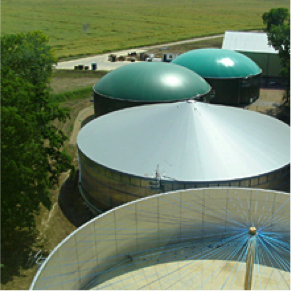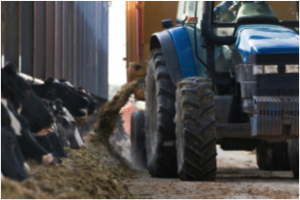The Biogas Map provides details of all operational AD facilities in the UK, with links to plant websites where available. This page provides direct links to some excellent case studies, showcasing a range of types and scales of plant, and providing a wealth of detail for potential developers, investors and generally interested parties
The WRAP website includes case studies. Links to the facilities that received  support from the Environmental Transformation Fund (ETF) are profiled, with full case studies on the following:
support from the Environmental Transformation Fund (ETF) are profiled, with full case studies on the following:
- Staples Vegetables built an anaerobic digester to process out of specification and by-passed vegetables created by the existing vegetable harvesting and packaging process. Maize is also being grown on the farm to supplement the vegetable feedstock.
- Langage Farm in Devon was looking for a way to improve the grazing quality of its pasture land. It decided on anaerobic digestion to treat its factory waste and manure, returning the digestate to pasture to give significant increases in performance.
- GWE Biogas, based in East Yorkshire, was established to convert up to 50,000 tonnes of organic waste each year sourced from local authorities, food manufacturers and supermarkets, to energy.
- BV Dairy was looking to cut waste disposal costs, but quickly discovered that with anaerobic digestion it could also make savings to its significant energy bills. A video case study of the site can also be found here.
The Farming Futures website includes case studies of agricultural and horticultural facilities:
- Kemble Farms – In 2008 Kemble Farms Ltd completed the installation of a 300kW anaerobic digestion plant, which complemented their dairy unit and provided another income following fluctuating milk prices.
- Copys Green Farm – Cattle manure and silage from Stephen Temple’s dairy farm and whey from his cheese making enterprise are fed into the facility, producing biogas that can be used for heat and electricity production.
- APS Salads – Taking a whole farm approach to reducing the carbon and water footprint of their tomato crop. Using a combined heat and power unit, a ground source cooling pump and anaerobic digestion they have gained incredible efficiencies and cost savings.
- Lowbrook Farm – Owen Yeatman’s Nuffield Farming Scholarship researching biogas in 2004 prompted an investment for his own anaerobic digester facility. Even at a cost of £750,000, Owen is confident that his months of preparation will see him benefit financially in the long term.
 The RASE ‘Review of Anaerobic Digestion Plants on UK Farms’ includes detailed case studies for the following operational farm-based plants:
The RASE ‘Review of Anaerobic Digestion Plants on UK Farms’ includes detailed case studies for the following operational farm-based plants:
- Kemble Farms, Cirencester – 300kWe, slurry and silage.
- Copys Green Farm, Norfolk – 140kWe, slurry silage and cheese making waste.
- Hill Farm, Shropshire – slurry only, self-built plant, using heat-only on-site.
- Lodge Farm, Wrexham – 125kWe, slurry and chicken litter.
- Tuquoy Farm, Orkney – 6kWe, beef manure and grass silage.
- Bank Farm, Montgomery – 125kWe, slurry, chicken litter and apple pomace.
- Ryes Farm, Dumfries – slurry-only, using heat-only on-site.
- Corsock Farm, Kirkcudbrightshire – slurry and glycerol, using heat-only on-site.
The ADBA website provides details on more than 35 different AD projects from across Europe, covering a range of scales, processes and technologies. These include:
- Linstock Castle, Cumbria - 1200ac mixed dairy and arable farm operating a 1.1MW plant. The feedstock mix includes: muck and slurry from the dairy heifer rearing operation; grass silage; maize silage; and whole crop hybrid rye.
- QV Foods, Lincolnshire - 1.4 MW plant using waste from on-site packing and processing operations, as well as vegetable food waste from other sources. Also growing 8,000 tonnes of maize a year for the plant, on 170ha of land unsuitable for potato production. In the future, rye and energy beet could also be considered as feedstock for the plant.
- North British Distillery, Edinburgh – using high rate AD to process liquid distillery waste.
- PDM ReFood, Doncaster – using commercial and household food waste to generate up to 4MWe
The BPEX website includes a case study of James Hart and Jeremy Iles' anaerobic digester in Gloucestershire which uses pig slurry, farmyard manure, chicken litter and maize silage to produce heat and power for use in their farmhouse. Surplus electricity is exported to the grid and digestate is used on their arable land.
Case studies are also readily available on developer websites. Examples include:
- Singleton Birch (PlanET), a 1.5MWe plant in North Lincolnshire fed by maize silage, poultry manure, vegetable waste, potato peelings and sugar beet silage
- Lea Hall Farm (Marches), a 500kWe plant in North Shropshire fed by poultry litter, slurries, maize, silage and sugar beet
- Clapham Lodge (JFS & Associates), a 1.5MWe plant in North Yorkshire fed by 50,000 tonnes per year of food waste
NNFCC has conducted multiple successful AD-based projects. These include:
- A review of the most appropriate bioenergy options for a UK University
- Assisting Springvale Energies with their financial support scheme compliance
- Conducting Carbon Calculation for a variety of clients
